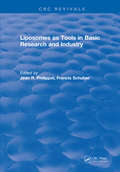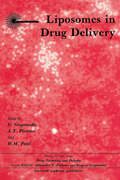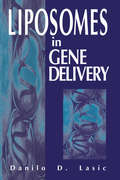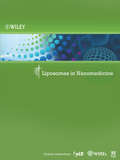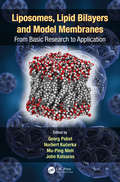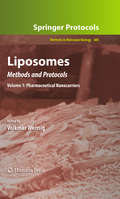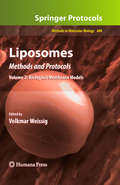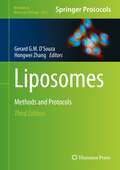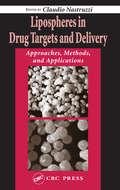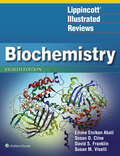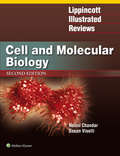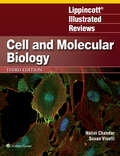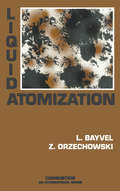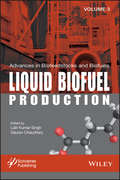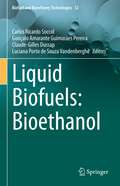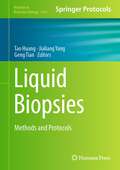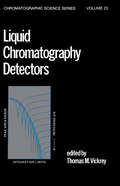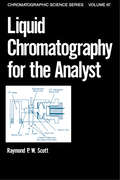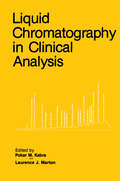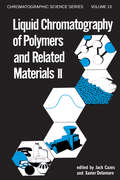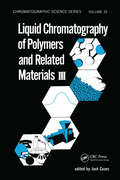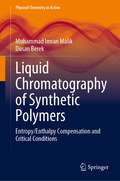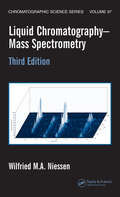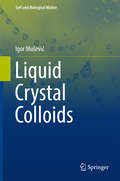- Table View
- List View
Liposomes as Tools in Basic Research and Industry (CRC Press Revivals)
by Jean R. Philippot Francis SchuberThis book is devoted to a broader understanding of liposomes as a versatile tool used in many domains, including basic research and applied technology, focusing on less common applications and recent developments.Over the past few years, new types of liposomes made of nonphospholipid molecules have opened new perspectives in applications. These lipid vesicles, already used in cosmetology, are being manufactured for industrial and agricultural uses. However, "Stealth" liposomes, pH-sensitive liposomes, and cationic liposomes have enlarged and improved the application field of liposomes in clinical research. The book covers these different uses of liposomes with particular attention to new formulations and new applications.
Liposomes in Drug Delivery
by AlexanderT. FlorenceThis book is an outcome of the conference on the liposomes in drug delivery: 21 years held in University of London, in 1990. It covers themes such as novel carrier systems, newer and potential responsive or pulsatile systems, or systems such as liposomes which have a longer pedigree.
Liposomes in Gene Delivery
by Danilo D. LasicMany specialists are not familiar with both drug delivery and the molecular biology of DNA vectors. Liposomes in Gene Delivery covers both-molecular biologists will gain a basic knowledge of lipids, liposomes, and other gene delivery vehicles; lipid and drug delivery scientists will better understand DNA, molecular biology, and DNA manipulation. Topics include an introduction to nucleic acids, a theoretical description of DNA, recombinant technology, lipids and liposomes, stability and interaction properties of lipids and liposomes, complexation of lipids and liposomes with DNA plasmids, gene expression of genosomes in various models, structure-activity relationships, and transfection models. This is an excellent introductory text for graduate students, scientists, and researchers in molecular and cell biology, genetics, biochemistry, physical chemistry, colloid science, pharmacology, molecular science, and medicine.
Liposomes in Nanomedicine
by WileyLiposomes are synthetic vesicles consisting of one or more phospholipid bilayers, able to accommodate water- and lipid-soluble molecules. They are used as a delivery system for drugs, genes and vaccines in therapeutics.This collection of reviews and laboratory protocols provides the reader with an excellent introduction to some of the many ways in which liposomes can be labeled and used in both diagnostic and therapeutic applications. Diagnostic uses include attachment of radiolabels to track nanometer-sized liposomes in the body in a quantitative fashion using PET or SPECT imaging. The ability to track the uptake of liposomes in humans and research animals on a whole-body basis provides an excellent tool for developing liposome-based drug delivery agents. The attachment of therapeutic molecules to liposomes also has great promise in cancer therapy. In addition, recent developments in the use of liposomes carrying therapeutic radionuclides for cancer therapy will be reviewed. A laboratory protocol is also provided to illustrate how liposomes are routinely used to transfect (deliver) DNA into cells.This e-book is a curated collection from eLS, WIREs, and Current Protocols on the topic of liposomes in nanomedicine. It is a great introduction to the field for students or interdisciplinary collaborators.Table of Contents:IntroductionLiposomes eLSGregory Gregoriadis, Yvonne PerrieTechniques & ApplicationsTopical and mucosal liposomes for vaccine delivery WIREs Nanomedicine and NanobiotechnologyEder Lilia Romero, Maria Jose MorillaRadioactive liposomes WIREs Nanomedicine and NanobiotechnologyWilliam Thomas Phillips, Beth Ann Goins, Ande BaoATP-loaded liposomes for treatment of myocardial ischemia WIREs Nanomedicine and NanobiotechnologyWilliam C. Hartner, Daya D. Verma, Tatyana S. Levchenko, Eugene A. Bernstein, Vladimir P. TorchilinMagnetoliposomes as magnetic resonance imaging contrast agents WIREs Nanomedicine and NanobiotechnologyStefaan J. Soenen, Greetje Vande Velde, Ashwini Ketkar?]Atre, Uwe Himmelreich, Marcel De CuyperMethodsGene Delivery Using Helper Virus-Free HSV-1 Amplicon Vectors Current Protocols in NeuroscienceAndrea S. Laimbacher, Cornel Fraefel
Liposomes, Lipid Bilayers and Model Membranes: From Basic Research to Application
by Georg Pabst John Katsaras Mu-Ping Nieh Norbert KuCerkaAs a result of their unique physical properties, biological membrane mimetics, such as liposomes, are used in a broad range of scientific and technological applications. Liposomes, Lipid Bilayers and Model Membranes: From Basic Research to Application describes state-of-the-art research and future directions in the field of membranes, which has evo
Liposomes, Volume 1: Pharmaceutical Nanocarriers
by Volkmar WeissigWith nearly one hundred years of intensive study, lipids have proven to be a vital and ever-more-promising area of cell biological research. In Liposomes: Methods and Protocols, leading experts in the related fields explore cutting-edge experimental methods involving all aspects of lipids as essential components of the cell membrane. Volume 1: Pharmaceutical Nanocarriers focuses on the state-of-the-art aspects of developing liposome-based nanoscale drug delivery techniques, delving into the depths of the emerging field of pharmaceutical and biomedical nanotechnology. As a volume in the highly successful Methods in Molecular BiologyTM series, the chapters include introductions to their respective topics, lists of the necessary materials and reagents, step-by-step, readily reproducible laboratory protocols, and notes on troubleshooting and avoiding known pitfalls.<P><P> Comprehensive and authoritative, Liposomes: Methods and Protocols promises to be an essential source of practical know-how for every investigator, young and seasoned alike, whose research area involves in one way or another phospholipids, glycolipids, or cholesterol.
Liposomes, Volume 2: Biological Membrane Models
by Volkmar WeissigWith nearly one hundred years of intensive study, lipids have proven to be a vital and ever-more-promising area of cell biological research. In Liposomes: Methods and Protocols, leading experts in the related fields explore cutting-edge experimental methods involving all aspects of lipids as essential components of the cell membrane. Volume 2: Biological Membrane Models focuses on detailed methods for the use of liposomes in studying a variety of biochemical and biophysical membrane phenomena concomitant with chapters describing a great palette of state-of-the-art analytical technologies. As a volume in the highly successful Methods in Molecular Biology™ series, the chapters include introductions to their respective topics, lists of the necessary materials and reagents, step-by-step, readily reproducible laboratory protocols, and notes on troubleshooting and avoiding known pitfalls.<P><P> Comprehensive and authoritative, Liposomes: Methods and Protocols promises to be an essential source of practical know-how for every investigator, young and seasoned alike, whose research area involves in one way or another phospholipids, glycolipids, or cholesterol. Comprehensive and authoritative, Liposomes: Methods and Protocols promises to be an essential source of practical know-how for every investigator, young and seasoned alike, whose research area involves in one way or another phospholipids, glycolipids, or cholesterol.
Liposomes: Methods and Protocols (Methods in Molecular Biology #2622)
by Hongwei Zhang Gerard G. M. D’SouzaThis third edition provides new and updated chapters detailing preparation of liposomes, physicochemical characterization of liposomes, lipid analysis, drug encapsulation, surface modification, stimuli response as well as cellular interaction, and biodistribution. Also included is an updated chapter on the history and evolution of the field of liposomology. Written in the format of the highly successful Methods in Molecular Biology series, each chapter includes an introduction to the topic, lists necessary materials and reagents, includes tips on troubleshooting and known pitfalls, and step-by-step, readily reproducible protocols. Authoritative and cutting-edge, Liposomes: Methods and Protocols, Third Edition aims to serve as a reference for graduate students, post-doctoral researchers as well as established investigators utilizing lipid-based systems.
Lipospheres in Drug Targets and Delivery: Approaches, Methods, and Applications
by Claudio NastruzziLipospheres in Drug Targets and Delivery: Approaches, Methods, and Applications presents an overview of the most recent applications of lipospheres primarily in the field of medicine, pharmaceutics, and biotechnology. It includes chapters on preparation, characterization, delivery (of peptides, proteins, vaccines, nucleic acids), therapeutic applic
Lippincott Illustrated Reviews: Biochemistry (Lippincott Illustrated Reviews Series)
by Emine E Abali Susan D Cline David S Franklin Susan M ViselliPraised by faculty and students for more than two decades, Lippincott® Illustrated Reviews: Biochemistry is the long-established go-to resource for mastering the essentials of biochemistry. This best-selling text helps students quickly review, assimilate, and integrate large amounts of critical and complex information, with unparalleled illustrations that bring concepts to life. Like other titles in the popular Lippincott® Illustrated Review Series, this text follows an intuitive outline organization and boasts a wealth of study aids that clarify challenging information and strengthen retention and understanding. This updated and revised edition emphasizes clinical application and features new exercises, questions, and accompanying digital resources to ready students for success on exams and beyond.
Lippincott Illustrated Reviews: Cell and Molecular Biology (Lippincott Illustrated Reviews Series)
by Nalini Chandar Susan ViselliNow in its second edition, Lippincott Illustrated Reviews: Cell and Molecular Biology continues to provide a highly visual presentation of essential cell and molecular biology, focusing on topics related to human health and disease.
Lippincott Illustrated Reviews: Cell and Molecular Biology (Lippincott Illustrated Reviews Series)
by Nalini Chandar Susan ViselliUp to date, easy to use, and rich with vibrant illustrations, Lippincott® Illustrated Reviews: Cell and Molecular Biology, 3rd Edition, provides a highly visual presentation of essential cell and molecular biology with a focus on topics related to human health and disease. This engaging approach incorporates all of the most popular features of the bestselling Lippincott® Illustrated Reviews series, including abundant full-color illustrations, chapter summaries, and review questions that link basic science to real-life clinical situations. The updated, versatile 3rd Edition can be used for a standalone cell biology course in medical, health professions, or other graduate and upper-level undergraduate programs; as a review for course and board exams; or in conjunction with other Lippincott® Illustrated Reviews for a seamless integrated course.
Liquid Atomization
by L.P. BayvelCovering the basics of liquid atomization, this book familiarizes readers with the physical processes of liquid atomization, the main types of atomizers and their design, measurements of spray characteristics, experimental investigations of atomizers, and application of atomizers. It demonstrates how to calculate and design atomizers and how to mea
Liquid Biofuel Production
by Gaurav Chaudhary Lalit Kumar SinghLiquid Biofuel Production by Lalit Kumar Singh (Editor), Gaurav Chaudhary (Editor)
Liquid Biofuels: Bioethanol (Biofuel and Biorefinery Technologies #12)
by Carlos Ricardo Soccol Gonçalo Amarante Guimarães Pereira Claude-Gilles Dussap Luciana Porto de Souza VandenbergheThis book covers the present and future of bioethanol biorefinery technologies. It discusses the efficient use of feedstock in bioethanol production, and critically reviews the environmental sustainability of bioethanol production. In addition, it describes the integrated production of bioelectricity, biopolymers, organic acids, and other biomolecules, as well as the use of process-related liquid and solid byproducts and/or wastes during bioethanol generation.Since the bioethanol industry has also led the automotive industry to explore new avenues, this book summarizes the various aspects of ethanol motorization, hybrid engine development, and biofuel electrification. For decades, clean and renewable alternatives have been sought to reduce dependence on petroleum-based fossil fuels and CO2 emissions. Bioethanol appears as one of the best solutions for the production of biofuels, bioenergy and biochemicals, along with the establishment of new biorefinery concepts and a circular bioeconomy. Therefore, the ideas and technologies presented in this book contribute to the UN Sustainable Development Goal 7: Affordable and Clean Energy.This book is a useful reference for postgraduate students and researchers interested in biorefinery and biofuel technologies, both in academia- and commercial laboratories. Early career scientists can use it to fast track into the field. Advanced scientists will find it helpful to gain a broader overview of the field beyond their area of specialization.
Liquid Biofuels: Fundamentals, Characterization, and Applications
by Krushna Prasad ShadangiCompiled by a well-known expert in the field, Liquid Biofuels provides a profound knowledge to researchers about biofuel technologies, selection of raw materials, conversion of various biomass to biofuel pathways, selection of suitable methods of conversion, design of equipment, selection of operating parameters, determination of chemical kinetics, reaction mechanism, preparation of bio-catalyst: its application in bio-fuel industry and characterization techniques, use of nanotechnology in the production of biofuels from the root level to its application and many other exclusive topics for conducting research in this area. Written with the objective of offering both theoretical concepts and practical applications of those concepts, Liquid Biofuels can be both a first-time learning experience for the student facing these issues in a classroom and a valuable reference work for the veteran engineer or scientist. The description of the detailed characterization methodologies along with the precautions required during analysis are extremely important, as are the detailed description about the ultrasound assisted biodiesel production techniques, aviation biofuels and its characterization techniques, advance in algal biofuel techniques, pre-treatment of biomass for biofuel production, preparation and characterization of bio-catalyst, and various methods of optimization. The book offers a comparative study between the various liquid biofuels obtained from different methods of production and its engine performance and emission analysis so that one can get the utmost idea to find the better biofuel as an alternative fuel. Since the book covers almost all the field of liquid biofuel production techniques, it will provide advanced knowledge to the researcher for practical applications across the energy sector. A valuable reference for engineers, scientists, chemists, and students, this volume is applicable to many different fields, across many different industries, at all levels. It is a must-have for any library.
Liquid Biopsies: Methods and Protocols (Methods in Molecular Biology #2695)
by Tao Huang Jialiang Yang Geng TianThis book analyzes liquid biopsy applications in cancer and other diseases. Chapters guide readers through the latest technologies and analysis methods for liquid biopsy,liquid biopsy in cancer, role of liquid biopsies in rheumatoid arthriti, cell-free circulating DNA profiling in patients with skin diseases, circulating non-coding RNAs, and exomes. Written in the format of the highly successful Methods in Molecular Biology series, each chapter includes an introduction to the topic, lists necessary materials and reagents, includes tips on troubleshooting and known pitfalls, and step-by-step, readily reproducible protocols. Authoritative and cutting-edge, Liquid Biopsies: Methods and Protocols aims to attract more researchers and clinicians to study the diagnosis, immunotherapy, and prognosis of cancer and other diseases with liquid biopsy analysis.
Liquid Chromatography Detectors
by T. M. VickreyThis book documents the principles of operation, the advantages and drawbacks, and the potential future of currently available liquid chromatographic detectors. In offering a snapshot of the current technology, it provides clear explanations and possible new horizons for both beginners and experts.
Liquid Chromatography for the Analyst
by Raymond P.W. ScottThis work provides a clear presentation of the chromatographic process - demonstrating the functions of all associated instrumentation and the procedures necessary to obtain accurate qualitative and quantitative results. The work supplies a host of applications from a variety of sources to help identify the best equipment, the most appropriate colu
Liquid Chromatography in Clinical Analysis
by Pokar M. Kabra Laurence J. MartonLiquid Chromatography in Clinical Analysis
Liquid Chromatography of Polymers and Related Materials, II
by Jack Cazes; Xavier DelamareThis book covers a range of topics of interest to those involved in the fractionation and characterization of polymeric substances. It deals with problems that are encountered in modern gel permeation chromatography with dual detection when calculating average molecular weights.
Liquid Chromatography of Polymers and Related Materials. III (Chromatographic Science Ser. #19)
by Jack CazesThis book describes new gel permeation chromatography/liquid chromatography applications and techniques that will provide polymer scientists and practitioners with insight into the development of new polymers and plastics and improvement of existing materials.
Liquid Chromatography of Synthetic Polymers: Entropy/Enthalpy Compensation and Critical Conditions (Physical Chemistry in Action)
by Muhammad Imran Malik Dusan BerekThis book elucidates the peculiar phenomenon of entropy/enthalpy compensation that takes place in high performance liquid chromatography (HPLC) of polymers. Numerous publications, including some books, are devoted to molecular characterization of synthetic polymers, materials presently produced in large and steadily growing quantities, applying methods of HPLC. A knowledge of the molecular characteristics of polymers is indispensable, not only for their proper applications but also for their recycling and remediation. Polymer scientists generally focus on synthesis and potential applications of polymers while not giving due attention to an important central link, their comprehensive characterization in context of development of structure-property correlations. To fill this gap is one of the aims of the present book. The process of entropy/enthalpy compensation plays a decisive role in the advanced method of polymer characterization such as liquid chromatography at critical conditions, eluent gradient interaction chromatography, and temperature gradient interaction chromatography. All chemists working on any aspect of polymer science will find this book a valuable resource for the development of structure-property correlations.
Liquid Chromatography-Mass Spectrometry (Chromatographic Science Series)
by Wilfried M.A. NiessenA constructive evaluation of the most significant developments in liquid chromatography-mass spectrometry (LC-MS) and its uses for quantitative bioanalysis and characterization for a diverse range of disciplines, Liquid Chromatography-Mass Spectrometry, Third Edition offers a well-rounded coverage of the latest technological developments and
Liquid Crystal Colloids
by Igor MuševičThis book brings together the many concepts and discoveries in liquid crystal colloids contributed over the last twenty years and scattered across numerous articles and book chapters. It provides both a historical overview of the development of the field and a clear perspective on the future applications in photonics. The book covers all phenomena observed in liquid crystal colloids with an emphasis on experimental tools and applications of topology in condensed matter, as well as practical micro-photonics applications. It includes a number of spectacular manifestations of new topological phenomena not found or difficult to observe in other systems. Starting from the early works on nematic colloids, it explains the basics of topological defects in ordered media, charge and winding, and the elastic forces between colloidal particles in nematics. Following a detailed description of experimental methods, such as optical tweezing and particle tracking, the book eases the reader into the theoretical part, which deals with elastic deformation of nematic liquid crystals due to inclusions and surface alignment. This is discussed in the context of basic mean field Landau-de Gennes Q-tensor theory, with a brief explanation of the free-energy minimization numerical methods. There then follows an excursion into the topology of complex nematic colloidal structures, colloidal entanglement, knotting and linking. Nematic droplets, shells, handlebodies and chiral topological structures are addressed in separate chapters. The book concludes with an extensive chapter on the photonic properties of nematic dispersions, presenting the concept of integrated soft matter photonics and discussing the concepts of nematic and chiral nematic microlasers, surface-sensitive photonic devices and smectic microfibers. The text is complemented by a large bibliography, explanatory sketches and beautiful micrographs.
